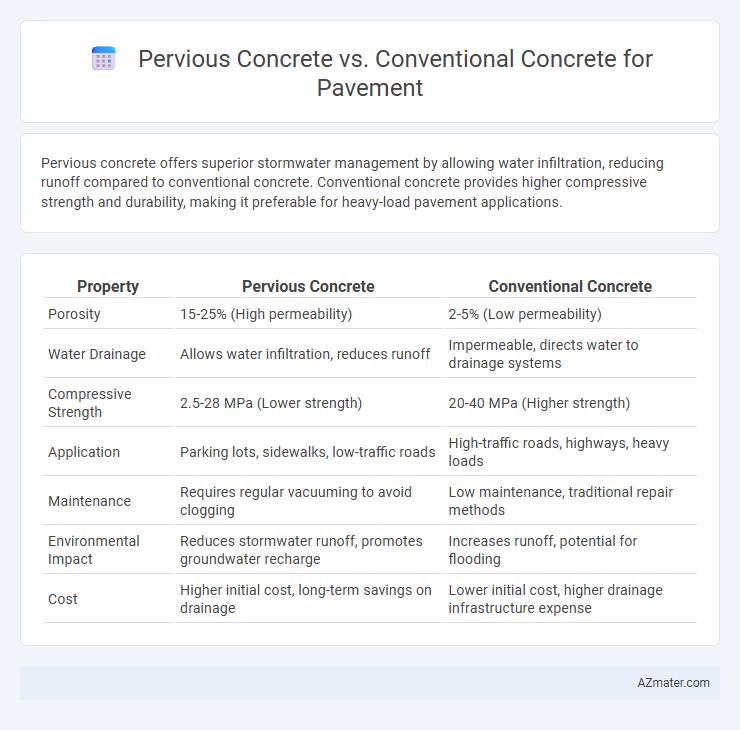Pervious concrete offers superior stormwater management by allowing water infiltration, reducing runoff compared to conventional concrete. Conventional concrete provides higher compressive strength and durability, making it preferable for heavy-load pavement applications.
Table of Comparison
| Property | Pervious Concrete | Conventional Concrete |
|---|---|---|
| Porosity | 15-25% (High permeability) | 2-5% (Low permeability) |
| Water Drainage | Allows water infiltration, reduces runoff | Impermeable, directs water to drainage systems |
| Compressive Strength | 2.5-28 MPa (Lower strength) | 20-40 MPa (Higher strength) |
| Application | Parking lots, sidewalks, low-traffic roads | High-traffic roads, highways, heavy loads |
| Maintenance | Requires regular vacuuming to avoid clogging | Low maintenance, traditional repair methods |
| Environmental Impact | Reduces stormwater runoff, promotes groundwater recharge | Increases runoff, potential for flooding |
| Cost | Higher initial cost, long-term savings on drainage | Lower initial cost, higher drainage infrastructure expense |
Introduction to Pervious and Conventional Concrete
Pervious concrete features a porous structure designed to allow water infiltration, reducing runoff and promoting groundwater recharge, making it ideal for sustainable pavement solutions. Conventional concrete, composed of cement, aggregates, and water, provides high compressive strength and durability but lacks permeability, leading to surface water accumulation. Understanding the fundamental differences in composition and functionality is crucial for selecting appropriate concrete types based on environmental impact and pavement performance requirements.
Composition and Material Differences
Pervious concrete consists of a mixture of coarse aggregates, cement, water, and little to no fine aggregates, creating a porous structure that allows water infiltration. Conventional concrete uses a blend of coarse aggregates, fine aggregates (sand), cement, and water, resulting in a dense, impermeable matrix. The key material difference lies in the absence of fine aggregates in pervious concrete, which significantly influences its permeability and structural characteristics for pavement applications.
Permeability and Drainage Capabilities
Pervious concrete exhibits significantly higher permeability compared to conventional concrete, allowing water to pass through its porous structure and reducing surface runoff. This enhanced drainage capability helps mitigate flooding and promotes groundwater recharge, making pervious concrete ideal for sustainable pavement solutions. Conventional concrete, with its dense composition, lacks these permeability features and tends to contribute to water accumulation and poor drainage in paved surfaces.
Structural Strength and Load-Bearing Capacity
Pervious concrete typically exhibits lower compressive strength compared to conventional concrete, with average values ranging from 2,500 to 4,000 psi versus 4,000 to 7,000 psi for traditional mixes used in pavement applications. Despite its reduced structural strength, pervious concrete effectively supports low to moderate traffic loads while providing superior stormwater management through enhanced permeability. Conventional concrete remains the preferred choice for high-load-bearing pavement structures due to its higher durability and resistance to heavy traffic stress.
Sustainability and Environmental Impact
Pervious concrete significantly enhances sustainability in pavement applications by enabling stormwater infiltration, which reduces runoff, mitigates urban heat island effects, and replenishes groundwater supplies. Unlike conventional concrete, which is dense and impermeable, pervious concrete reduces the need for extensive drainage systems and lowers pollutant transport to water bodies. The environmental benefits include decreased water pollution, improved aquifer recharge, and reduced surface flooding, making pervious concrete a superior eco-friendly choice for sustainable infrastructure development.
Installation Methods and Construction Time
Pervious concrete installation requires careful mixing and placement to maintain its porous structure, often involving specialized equipment and slower curing times compared to conventional concrete. Conventional concrete benefits from standardized mixing, pouring, and finishing techniques that streamline installation and reduce construction time. The porous nature of pervious concrete demands precise moisture control and compaction, which can extend project timelines relative to the faster, more predictable setting of conventional concrete pavements.
Maintenance Requirements and Longevity
Pervious concrete offers superior water drainage, significantly reducing surface water accumulation and minimizing freeze-thaw damage, which lowers maintenance needs compared to conventional concrete. Conventional concrete pavements require frequent sealing and crack repairs due to poor permeability and water retention, accelerating surface deterioration. The longevity of pervious concrete can exceed 20 years with proper maintenance, while conventional concrete typically demands more intensive upkeep to reach similar service life.
Cost Comparison and Economic Considerations
Pervious concrete typically incurs higher initial material and installation costs compared to conventional concrete due to specialized mix design and the need for skilled labor, but it can reduce long-term expenses by minimizing stormwater management infrastructure and lowering runoff treatment costs. Conventional concrete offers lower upfront costs and faster installation, yet often requires additional drainage systems that increase overall project expenditure. Evaluating total lifecycle costs reveals that pervious concrete can provide significant economic benefits in sustainable urban drainage systems and regulatory compliance zones.
Applications and Suitability for Pavement Projects
Pervious concrete is ideal for pavement projects requiring enhanced stormwater management and infiltration, reducing runoff and promoting groundwater recharge. Conventional concrete offers superior strength and durability, making it suitable for high-traffic pavements with heavy loads and minimal permeability needs. Choosing between the two depends on specific project goals such as environmental impact, load-bearing requirements, and local climate conditions.
Pros and Cons: Choosing the Right Concrete for Pavements
Pervious concrete offers superior water drainage, reducing surface runoff and enhancing groundwater recharge, which makes it ideal for sustainable pavement projects aimed at managing stormwater. Conventional concrete provides higher compressive strength and durability, suitable for heavy traffic loads and long-lasting pavement structures requiring minimal maintenance. The selection between pervious and conventional concrete depends on balancing the need for permeability and environmental benefits against structural integrity and load-bearing capacity.

Infographic: Pervious concrete vs Conventional concrete for Pavement
 azmater.com
azmater.com